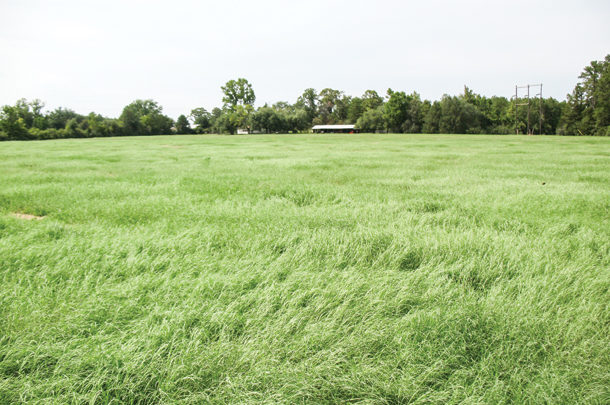A good soil analysis allows producers to determine whether or not to lime and how much phosphorus (P) and potassium (K) to use. Soil testing can also determine whether enough residual nitrogen (N) is in the soil to reduce N fertilizer recommendations.
A good soil testing strategy is dependent upon taking a good sample. It is recommended to test every field of introduced forages at least once every three years. Hay meadows should be sampled and analyzed annually due to high yield expectation and frequent nutrient turnover. A sampling depth of zero to 6 inches is recommended.
Cores should be collected from 10 to 15 different locations within the field and thoroughly mixed to make one composite sample. Collect one composite sample for every 10 to 40 acres. A separate sample should be taken for areas with different soil types, areas with different land uses or fertilizer uses and areas with different terrain.
Nitrogen, phosphorus and potassium are the most crucial nutrients for producing high-quality bermudagrass. These nutrients are usually the most limiting of fertilizer-applied plant nutrients in sandy soils. On deep, sandy soils in high-rainfall regions, all three of these plant nutrients are usually deficient and need to be applied when establishing introduced forages. In the higher-organic-matter and higher-clay-content soils, nitrogen and phosphorus are usually the most limiting.
Nitrogen applied to actively growing grass pastures can be lost from the soil when plants take it into their roots, excess rainfall leaches the nitrate (NO3) form of N down into the soil, the ammonium form may be converted to ammonia gas (NH3) and will volatilize, and aerobic bacteria may use the oxygen from the NO3 forms of N. When they have taken most of the oxygen, the N goes back into the atmosphere as nitrogen gas.
If N is applied to a dry soil surface, and if no rain or dew is received for 60 days under very low-humidity conditions, the nitrogen will remain on the soil surface to be dissolved and moved into the soil when rains finally do arrive. Bermudagrass responds well to nitrogen fertilizer, and applications can be targeted to meet producers’ needs for hay production or pasture carrying capacity.
Phosphorus is vital to plants for developing a healthy root system and reaching optimum forage yield. For successful establishment of any new forages, phosphorus is critical for root development. Phosphorus applied during the establishment phase can improve the overall success of the stand. Drought recovery may be improved with phosphorus applications to support root regrowth.
Lack of proper soil fertility will prevent drought-stressed forages from recovering. Losses of P from the soil are most closely associated with soil erosion. The use of perennial forages, such as bermudagrass, ensures complete soil cover and offers protection from soil erosion.
A challenge for the Southeast
Next to inadequate rainfall, thinning of hybrid bermudagrass stands due to inadequate levels of potassium is one of the biggest soil fertility issues facing forage growers in the Southeast.
Potassium in mostly sandy, acidic soils is usually low and must be applied as one of the plant nutrients for bermudagrass production. Research by Texas A&M AgriLife and by scientists at other universities has shown improved persistence and yield of bermudagrass stands adequately fertilized with potassium. Blackland soils and other alkaline (high soil pH), high-clay-content soils usually contain more plant-available potassium.
Potassium deficiencies in soils have also been associated with increased incidence of bipolaris (Bipolaris cynodontis), a plant disease that has been related to bermudagrass stand decline. Bipolaris can develop during warm weather when patterns of wetting and drying occur in the thatch. Fertilization of bermudagrass according to soil test recommendations should help overcome potassium deficiencies. Multiple applications (50 to 60 pounds of P2O5) should be made to reduce bermudagrass luxury consumption of potassium. Luxury consumption is the inefficient use of potassium.
Lime is often recommended for pastures and hay meadows in order to increase soil pH. Many forages can be sensitive to soil pH, especially acidic soils (soil pH less than 7). Maintaining an appropriate soil pH can increase nutrient use efficiency, meaning plant roots have the capability to utilize nutrients from the soil and use them for plant growth and persistence. Timely soil sampling is important because limestone requires both soil moisture and time to neutralize soil acidity. Early sampling and limestone application several months in advance of forage growth provide time for pH adjustment.
Maintaining soil fertility not only impacts production, persistence and nutritive value of our forages, it also helps reduce the need for weed control. Some weeds are not competitive with improved forage grass species if conditions are favorable for the improved species. From a management standpoint, this means: Maintain proper soil pH levels (species-dependent), apply fertilizer at the recommended rates and intervals, and prevent overgrazing. These best management practices can reduce the need for active weed control as well as improve overall forage production and persistence. ![]()
PHOTO: Next to inadequate rainfall, thinning of hybrid bermudagrass stands due to inadequate levels of potassium is one of the biggest soil fertility issues facing forage growers in the Southeast. Photo provided by Vanessa Corriher-Olson.

-
Vanessa Corriher-Olson
- Associate Professor and Extension Forage Specialist
- Texas A&M AgriLife Research and Extension Center
- Email Vanessa Corriher-Olson













